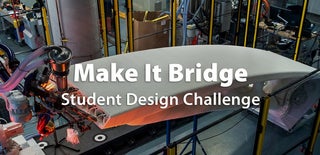Introduction: Pedestrian Keystone Bridge for Natural Environments
This is a multi-span arch bridge designed to be placed in Jersey City Reservoir #3 which is now a nature reserve. It would connects the surrounding land of the reservoir to a small island within, with the idea to fully immerse the visitor in the wildlife inhabiting the area, including great blue herons, falcons, as well as fish that may not be as visible from the shore.
The bridge itself is designed to be less modern and more natural looking for several reasons. The first is that the goal of the bridge is to immerse people into the natural environment; man-made such as glass or metal would not fit in as well. This is why bridge is designed to be made almost entirely out of stone. Furthermore, the reservoir site is also a historical one, with old stone steps and structures from previous inhabitants of the area. This stone bridge would be fitting because it matches the design and materials of the existing environment. Finally, the arches of the bridge allow for kayakers and boaters to pass under it easily.
Design by: Chinli, Grade 11
Supplies
Scaffolding:
- Metal beams
- Wooden planks
- Concrete for temporary scaffold support
Bridge Materials:
- Concrete for foundation
- Stones to build arches
- Stones for walkway
- Cement
Railing Materials:
- Stones
- Metal poles
- Nylon rope
- Cement
Step 1: Laying the Foundation for the Arches
The initial step in creating this bridge is forming a foundation for the bridge to sit on. Four piers (represented as black blocks in the image) sit mostly submerged beneath the water for the arches to sit on. In addition to these, the arch of the bridge results in a horizontal force moving outwards towards each shore, so a foundation is built into the ground to counteract this force.
Step 2: Metal Scaffolding
During this step, metal scaffolding, in addition to temporary supports for the scaffolding, are added in between the foundational piers (see previous step). This will be to support the arches while they are being built.
Step 3: Wooden Scaffolding
Wooden planks must be placed on top of the metal scaffolding to prevent the stones from falling through the holes in the scaffold.
Step 4: Building Stone Arches
Once the scaffolding is in place, the stone arches can then be built. Each arch is built from the outermost stone inwards towards the top of the arch. The two outer arches are built first, and then the center one is built. This is to ensure that the stones fit together and are symmetrical. In addition, because the arches push outwards in the horizontal direction, the center arch will push against the two outer arches, and the two outer arches will push back which means the forces will cancel out.
As each stone is being lain, cement is applied to connect the stones together ensuring durability.
Step 5: Building Walkway and Connecting Arches to Foundation
Once the arches are finished, the walkway and remaining support for the arches can be built. The stones between the arches and the ground (where the foundation is) negate the outward forces caused by the arch shape. Again, each brick is shaped, if necessary to fit the arch, and then cemented into place.
After all the stones are lain, steps are carved at each end.
Step 6: Removal of Scaffolding
Since the bridge is now fully supported by the foundation, the scaffolding can be removed. First the wooden planks, then the metal scaffolds and finally the supports for the metal scaffold.
Step 7: Railings
For the safety of pedestrians, railings are placed along the bridge. Each segment is composed of two stone slabs with a metal pole in between. Linking the stone and the metal are lightweight nylon cords so that even if someone is unable to see over the stone, they can still see over the bridge through the nylon cording.
Step 8: Done!

Runner Up in the
Make It Bridge



















